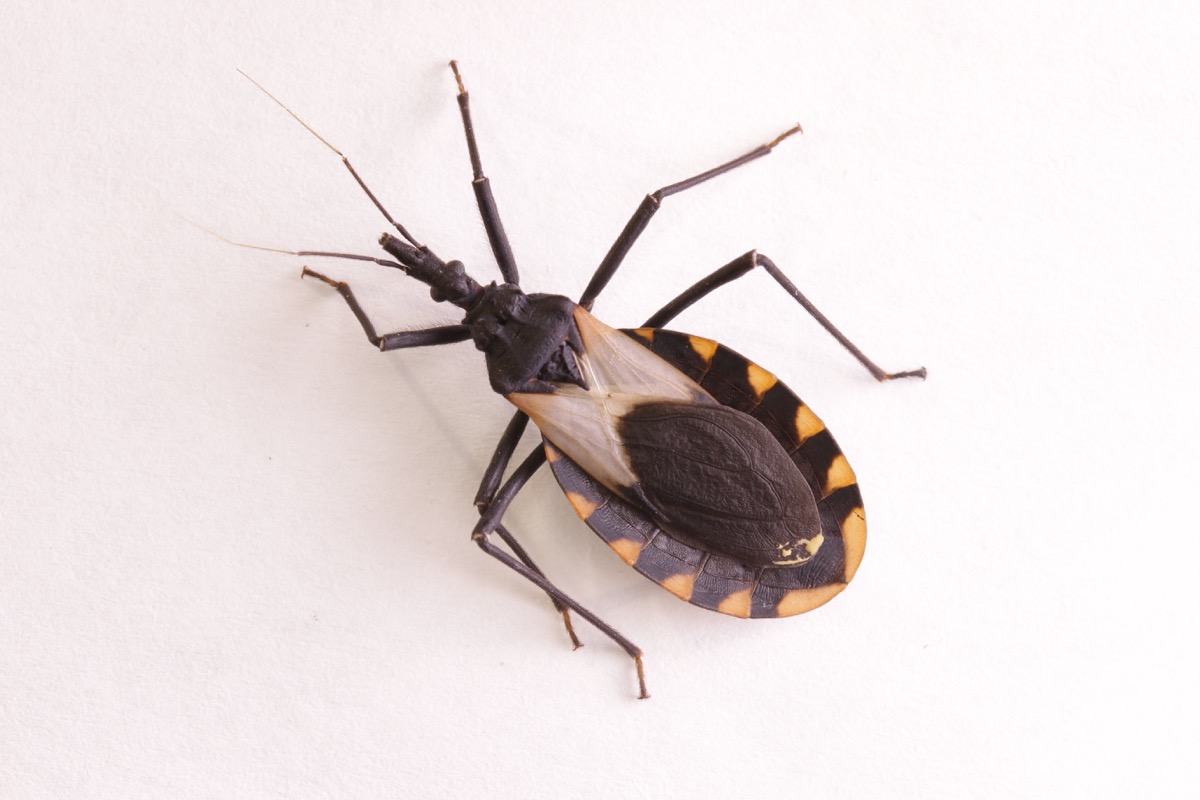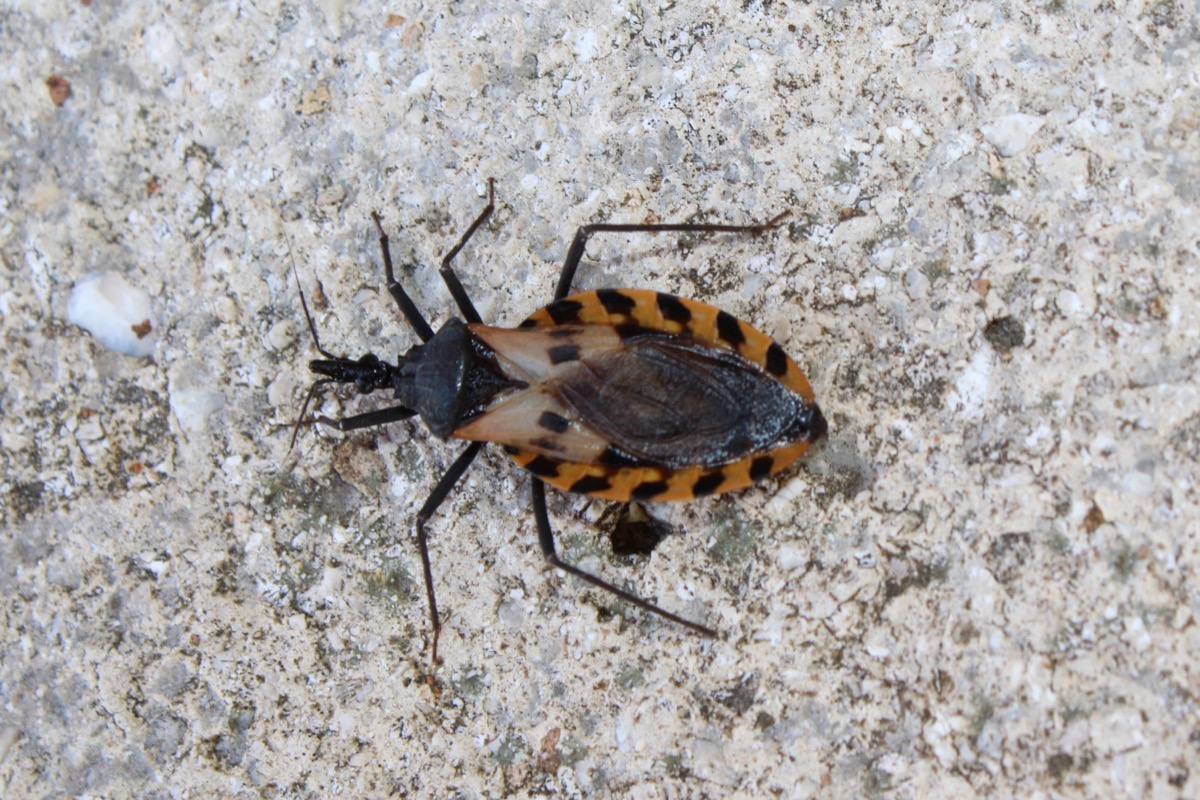If You See This Bug, Call Local Officials Immediately, Experts Warn

Many of us think bugs are gross, but it’s easy to forget that they could also be dangerous, too. Wasps, ticks, and black widow spiders are all known for the risks they pose to humans, but it’d be easy to ignore other less obviously nefarious bugs you come across. Recently, experts have warned of a certain creepy crawler that’s been spotted that could infect you with a potentially deadly disease. Local officials have asked people who see this dangerous bug to call and alert their health departments immediately. To find out which bug you need to keep an eye out for, read on.
RELATED: If You Live in These States, Don’t Drive With Your Windows Down, Officials Warn.
Call your local health officials if you see a kissing bug.

On June 14, the Nebraska Department of Health and Human Services (DHHS) alerted the public to the danger of a type of bug called a triatoma, colloquially known as the “kissing bug.” Local officials in the state have identified one type in particular, the Eastern blood-sucking conenose, that’s causing concern.
Kissing bugs, which are slightly less than an inch long, are identifiable by their black, flattened bodies and reddish-orange marks on the sides of their abdomen. Officials ask that if you see a kissing bug, you try to catch it. If you believe someone has been bit by one, contact the DHHS Vector-Borne Disease Program at (402) 471-2937. But if you see a kissing bug and don’t believe someone has been bit, reach out to Kyle Koch, the University of Nebraska-Lincoln’s insect diagnostician, at (402) 472-8691.
Kissing bugs have been seen in more than 20 states.

According to researchers at Texas A&M University, there are 11 types of kissing bugs that have been found in the U.S. in the following states: Alabama, Arizona, Arkansas, Delaware, Florida, Georgia, Ohio, Illinois, Indiana, Kansas, Kentucky, Louisiana, Maryland, Missouri, Montana, Nebraska, New Jersey, New Mexico, North Carolina, Oklahoma, Pennsylvania, South Carolina, Tennessee, Texas, Virginia, and West Virginia.
Arizona, New Mexico, and Texas have seen the most species and reports of kissing bugs bites, but they’re much more rare in Delaware, Illinois, Indiana, New Jersey, Pennsylvania, and West Virginia.
If you live outside of Nebraska and see a kissing bug, contact your state’s department of health services.
RELATED: 5 Things You’re Buying That Bring Bed Bugs Into Your House, Experts Say.
Go to your doctor if you see a kissing bug in your home.

Kissing bugs are so risky because they can carry a parasite called Trypanosoma cruzi (T. cruzi), which can result in Chagas disease, a potentially fatal infection for people and animals. According to the Texas A&M University scientists, about 55 percent of kissing bugs are infected with the T. cruzi parasite.
Even if a kissing bug is carrying the parasite, it’s not so easy for them to transmit Chagas disease as it’s only passed on through defecation. “Some kinds of kissing bugs poop while they are feeding; if a person scratches the kissing bug feces into the bite then the person can get sick. The parasite can also enter the body through the mouth or eye if someone touches their mouth or eye with a dirty hand,” the Texas A&M researchers say. “Dogs can become infected by eating kissing bugs.”
According to the statement from Nebraska’s DHHS, “Anyone who has seen kissing bugs in their home or who thinks they may have been bitten by one should talk to their doctor about getting tested for Chagas disease.”
Symptoms of Chagas disease can be difficult to detect.

In the first few weeks following infection, known as the acute phase, the Centers for Disease Control and Prevention (CDC) says people with Chagas disease may have no symptoms or mild ones, including fever, fatigue, body aches, rash, loss of appetite, diarrhea, and vomiting. It can be challenging to diagnose Chagas disease since these symptoms are similar to those of many other more common illnesses.
In the chronic phase, which can last for decades or someone’s entire life, many people with Chagas disease don’t have symptoms. However, about 20 to 30 percent of people with Chagas disease have cardiac or gastrointestinal complications, according to the CDC. The agency says Chagas disease causes approximately 10,000 deaths per year around the world.
RELATED: For more up-to-date information, sign up for our daily newsletter.
Kissing bugs could be hiding anywhere indoors or outdoors.

The Nebraska DHHS warns that these bugs could be lurking in many places indoors or outdoors. In the statement, officials say kissing bugs can be found under porches, between rocky structures, under cement, in nests or animal burrows, in outdoor dog houses, in chicken coops, and in rock, wood, or brush piles.
“They are mostly nocturnal and are often attracted to lights such as porch lights. Their bite is often painless and usually occurs when a person is still or asleep,” the Nebraska DHHS warns.
Getting infected with Chagas disease is not common, seeing as not all kissing bugs have the parasite and not all bites lead to transmission. But you should still be cautious if you see one and alert your local officials.